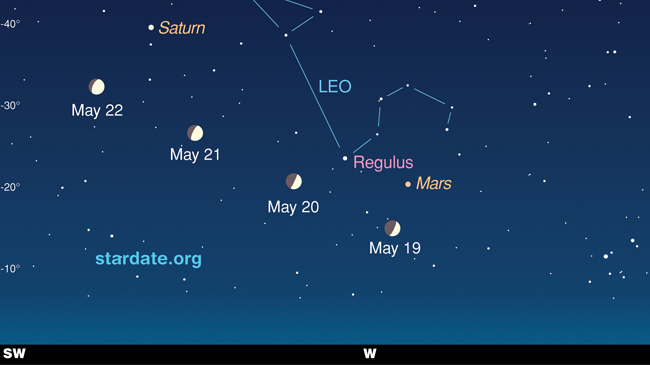Moon to Dance with Mars, Saturn and Bright Star This Week

The moon will take center stage in a cosmic dance withMars, Saturn and the bright star Regulus this week during a four-night skyengagement that begins May 19.
The celestial sky show will appear in the southwesternnight sky (weather permitting) beginning around nightfall, according to theastronomy magazine StarDate. This sky map shows where to look this week to spot the moon,Regulus, Saturn and Mars.
On Wednesday, May 19, Marswill appear above the moon while the bright star Regulus shines to the left andabove Mars. The red planet will actually look like a bright orange star,StarDate reported in a skywatching alert.
Regulus is the brightest star in the constellation Leo(The Lion) and is more massive, hotter and brighter than our sun, StarDatereported.
On Thursday, Regulus can be found to the upper right ofthe first-quarter moon, which will grow steadily fatter and fuller as the weekwears on. Mars will appear further off to the moon's right. [Fullmoon photos.]
Together, the moon, Mars and Regulus will form a skinnytriangle in the night sky until about 2 a.m. local time, when they sink belowthe horizon.
Saturnwill make its first appearance with the others on Friday, May 21 and shouldstand out in the due south direction of the sky.
Get the Space.com Newsletter
Breaking space news, the latest updates on rocket launches, skywatching events and more!
If you need help spotting Saturn or Mars Friday night,try to use the moon as your anchor. The moon will appear between Saturn ? whichshould look like a golden star ? in the south and Mars in the southwest.
The moon and Saturn will take one last cosmic tango onSaturday, May 22 when the moon shines below the ringed planet at sunset. Youcan find them by looking high in the southern sky.
StarDate is a bi-monthly astronomy and skywatching publicationof the McDonald Observatory at the University of Texas at Austin.
Skywatchers can also find the brightstar Arcturus in the constellation Bo?tes (The Herdsman) this week.
To find it, look at the Big Dipper. Imagine extending acurve of its bent handle about the length of the Big Dipper itself and you willultimately come to Arcturus.
Arcturus ranks as the fourth brightest star in the nightsky overall, behind Sirius, Canopus and Alpha Centauri.
- TheRings and Moons of Saturn
- StunningViews of Mars
- TheBrightest Stars in the Sky
Join our Space Forums to keep talking space on the latest missions, night sky and more! And if you have a news tip, correction or comment, let us know at: community@space.com.

Tariq is the Editor-in-Chief of Space.com and joined the team in 2001, first as an intern and staff writer, and later as an editor. He covers human spaceflight, exploration and space science, as well as skywatching and entertainment. He became Space.com's Managing Editor in 2009 and Editor-in-Chief in 2019. Before joining Space.com, Tariq was a staff reporter for The Los Angeles Times covering education and city beats in La Habra, Fullerton and Huntington Beach. In October 2022, Tariq received the Harry Kolcum Award for excellence in space reporting from the National Space Club Florida Committee. He is also an Eagle Scout (yes, he has the Space Exploration merit badge) and went to Space Camp four times as a kid and a fifth time as an adult. He has journalism degrees from the University of Southern California and New York University. You can find Tariq at Space.com and as the co-host to the This Week In Space podcast with space historian Rod Pyle on the TWiT network. To see his latest project, you can follow Tariq on Twitter @tariqjmalik.











